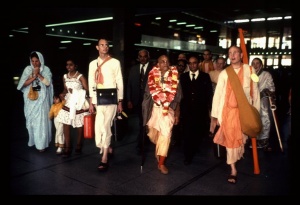CC Madhya 18.101: Difference between revisions
m (1 revision(s)) |
No edit summary |
||
| Line 1: | Line 1: | ||
{{ | [[Category:Sri Caitanya-caritamrta - Madhya-lila Chapter 18|C101]] | ||
<div style="float:left">'''[[Sri Caitanya-caritamrta|Śrī Caitanya-caritāmṛta]] - [[CC Madhya|Madhya-līlā]] - [[CC Madhya 18|Chapter 18: Lord Śrī Caitanya Mahāprabhu's Visit to Śrī Vṛndāvana]]'''</div> | |||
<div style="float:right">[[File:Go-previous.png|link=CC Madhya 18.100|Madhya-līlā 18.100]] '''[[CC Madhya 18.100|Madhya-līlā 18.100]] - [[CC Madhya 18.102|Madhya-līlā 18.102]]''' [[File:Go-next.png|link=CC Madhya 18.102|Madhya-līlā 18.102]]</div> | |||
{{CompareVersions|CC|Madhya 18.101|CC 1975|CC 1996}} | |||
{{RandomImage}} | |||
==== TEXT 101 ==== | ==== TEXT 101 ==== | ||
<div | <div class="verse"> | ||
kṛṣṇa kene daraśana dibe kali-kāle? | :kṛṣṇa kene daraśana dibe kali-kāle? | ||
nija-bhrame mūrkha-loka kare kolāhale | :nija-bhrame mūrkha-loka kare kolāhale | ||
</div> | </div> | ||
| Line 12: | Line 16: | ||
==== SYNONYMS ==== | ==== SYNONYMS ==== | ||
<div | <div class="synonyms"> | ||
''kṛṣṇa''—Lord Kṛṣṇa; ''kene''—why; ''daraśana''—interview; ''dibe''—would give; ''kali-kāle''—in this Age of Kali; ''nija-bhrame''—by their own mistake; ''mūrkha-loka''—foolish persons; ''kare kolāhale''—make a chaotic tumult. | |||
</div> | </div> | ||
| Line 19: | Line 23: | ||
==== TRANSLATION ==== | ==== TRANSLATION ==== | ||
<div | <div class="translation"> | ||
“Why would Kṛṣṇa appear in the Age of Kali? Foolish people who are mistaken are simply causing agitation and making a tumult. | “Why would Kṛṣṇa appear in the Age of Kali? Foolish people who are mistaken are simply causing agitation and making a tumult. | ||
</div> | </div> | ||
| Line 26: | Line 30: | ||
==== PURPORT ==== | ==== PURPORT ==== | ||
<div | <div class="purport"> | ||
Śrī Caitanya Mahāprabhu’s first statement (kṛṣṇa kene daraśana dibe kali-kāle) refers to the scriptures. According to scripture, Kṛṣṇa appears in Dvāpara-yuga, but He never appears as Himself in Kali-yuga. Rather, He appears in Kali-yuga in a covered form. As stated in Śrīmad-Bhāgavatam ([[SB 11.5.32]]), kṛṣṇa-varṇaṁ tviṣākṛṣṇaṁ sāṅgopāṅgāstra-pārṣadam. Kṛṣṇa appears in the Age of Kali in the garb of a devotee, Śrī Caitanya Mahāprabhu, who always associates with His internal soldiers—Śrī Advaita Prabhu, Śrī Nityānanda Prabhu, Śrīvāsa Prabhu and Gadādhara Prabhu. Although Balabhadra Bhaṭṭācārya was personally serving Lord Kṛṣṇa in His role as a devotee (Caitanya Mahāprabhu), he mistook Lord Kṛṣṇa for an ordinary man and an ordinary man for Lord Kṛṣṇa because he did not follow the rules set down by śāstra and guru. | Śrī Caitanya Mahāprabhu’s first statement (''kṛṣṇa kene daraśana dibe kali-kāle'') refers to the scriptures. According to scripture, Kṛṣṇa appears in Dvāpara-yuga, but He never appears as Himself in Kali-yuga. Rather, He appears in Kali-yuga in a covered form. As stated in [[Srimad-Bhagavatam|''Śrīmad-Bhāgavatam'']] ([[SB 11.5.32]]), ''kṛṣṇa-varṇaṁ tviṣākṛṣṇaṁ sāṅgopāṅgāstra-pārṣadam''. Kṛṣṇa appears in the Age of Kali in the garb of a devotee, Śrī Caitanya Mahāprabhu, who always associates with His internal soldiers—Śrī Advaita Prabhu, Śrī Nityānanda Prabhu, Śrīvāsa Prabhu and Gadādhara Prabhu. Although Balabhadra Bhaṭṭācārya was personally serving Lord Kṛṣṇa in His role as a devotee (Caitanya Mahāprabhu), he mistook Lord Kṛṣṇa for an ordinary man and an ordinary man for Lord Kṛṣṇa because he did not follow the rules set down by ''śāstra'' and ''guru''. | ||
</div> | </div> | ||
__NOTOC__ | |||
<div style="float:right; clear:both;">[[File:Go-previous.png|link=CC Madhya 18.100|Madhya-līlā 18.100]] '''[[CC Madhya 18.100|Madhya-līlā 18.100]] - [[CC Madhya 18.102|Madhya-līlā 18.102]]''' [[File:Go-next.png|link=CC Madhya 18.102|Madhya-līlā 18.102]]</div> | |||
__NOTOC__ | |||
__NOEDITSECTION__ | |||
Revision as of 08:44, 31 August 2021

A.C. Bhaktivedanta Swami Prabhupada
TEXT 101
- kṛṣṇa kene daraśana dibe kali-kāle?
- nija-bhrame mūrkha-loka kare kolāhale
SYNONYMS
kṛṣṇa—Lord Kṛṣṇa; kene—why; daraśana—interview; dibe—would give; kali-kāle—in this Age of Kali; nija-bhrame—by their own mistake; mūrkha-loka—foolish persons; kare kolāhale—make a chaotic tumult.
TRANSLATION
“Why would Kṛṣṇa appear in the Age of Kali? Foolish people who are mistaken are simply causing agitation and making a tumult.
PURPORT
Śrī Caitanya Mahāprabhu’s first statement (kṛṣṇa kene daraśana dibe kali-kāle) refers to the scriptures. According to scripture, Kṛṣṇa appears in Dvāpara-yuga, but He never appears as Himself in Kali-yuga. Rather, He appears in Kali-yuga in a covered form. As stated in Śrīmad-Bhāgavatam (SB 11.5.32), kṛṣṇa-varṇaṁ tviṣākṛṣṇaṁ sāṅgopāṅgāstra-pārṣadam. Kṛṣṇa appears in the Age of Kali in the garb of a devotee, Śrī Caitanya Mahāprabhu, who always associates with His internal soldiers—Śrī Advaita Prabhu, Śrī Nityānanda Prabhu, Śrīvāsa Prabhu and Gadādhara Prabhu. Although Balabhadra Bhaṭṭācārya was personally serving Lord Kṛṣṇa in His role as a devotee (Caitanya Mahāprabhu), he mistook Lord Kṛṣṇa for an ordinary man and an ordinary man for Lord Kṛṣṇa because he did not follow the rules set down by śāstra and guru.